Critical Appraisal: Fish Oil in Knee Osteoarthritis Research Study
VerifiedAdded on 2023/06/10
|9
|2262
|377
Report
AI Summary
This report presents a critical appraisal of the research article "Fish oil in knee osteoarthritis: a randomised clinical trial of low dose versus high dose." The study investigated the effects of different dosages of fish oil on knee osteoarthritis outcomes. The appraisal examines the study's research question, methodology, inclusion/exclusion criteria, randomization process, and outcome measures. It identifies potential risks of bias, including allocation, performance, and attrition bias, and assesses how the researchers addressed these biases. The report also evaluates the study's findings, the generalizability of the results, and their implications. The study concluded that high-dose fish oil did not show significant benefits over low-dose fish oil for knee osteoarthritis, and this appraisal provides a comprehensive analysis of the study's strengths and limitations.

Running head: RESEARCH AND EVIDENCE
Critical appraisal
Name of the Student
Name of the University
Author Note
Critical appraisal
Name of the Student
Name of the University
Author Note
Paraphrase This Document
Need a fresh take? Get an instant paraphrase of this document with our AI Paraphraser
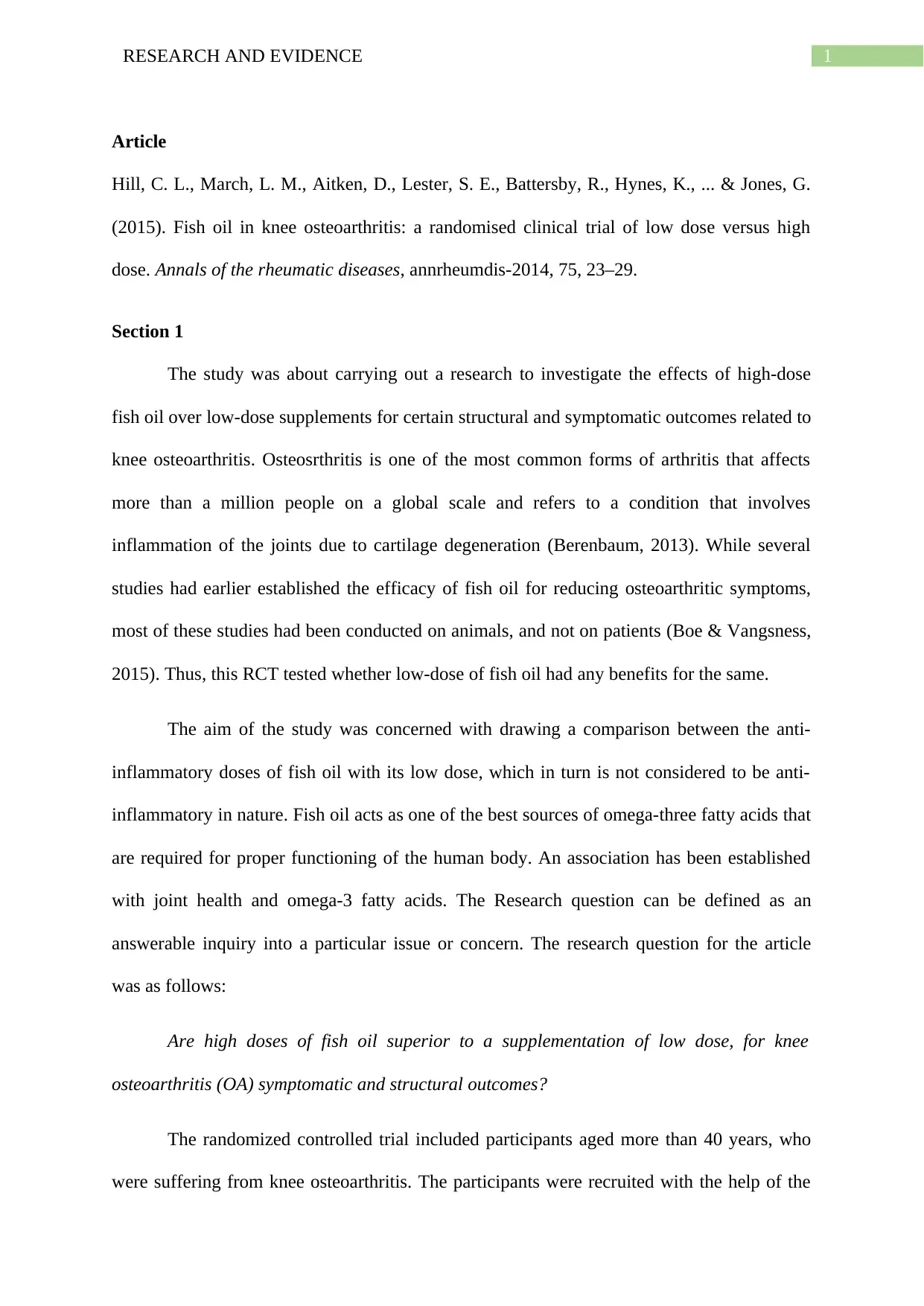
1RESEARCH AND EVIDENCE
Article
Hill, C. L., March, L. M., Aitken, D., Lester, S. E., Battersby, R., Hynes, K., ... & Jones, G.
(2015). Fish oil in knee osteoarthritis: a randomised clinical trial of low dose versus high
dose. Annals of the rheumatic diseases, annrheumdis-2014, 75, 23–29.
Section 1
The study was about carrying out a research to investigate the effects of high-dose
fish oil over low-dose supplements for certain structural and symptomatic outcomes related to
knee osteoarthritis. Osteosrthritis is one of the most common forms of arthritis that affects
more than a million people on a global scale and refers to a condition that involves
inflammation of the joints due to cartilage degeneration (Berenbaum, 2013). While several
studies had earlier established the efficacy of fish oil for reducing osteoarthritic symptoms,
most of these studies had been conducted on animals, and not on patients (Boe & Vangsness,
2015). Thus, this RCT tested whether low-dose of fish oil had any benefits for the same.
The aim of the study was concerned with drawing a comparison between the anti-
inflammatory doses of fish oil with its low dose, which in turn is not considered to be anti-
inflammatory in nature. Fish oil acts as one of the best sources of omega-three fatty acids that
are required for proper functioning of the human body. An association has been established
with joint health and omega-3 fatty acids. The Research question can be defined as an
answerable inquiry into a particular issue or concern. The research question for the article
was as follows:
Are high doses of fish oil superior to a supplementation of low dose, for knee
osteoarthritis (OA) symptomatic and structural outcomes?
The randomized controlled trial included participants aged more than 40 years, who
were suffering from knee osteoarthritis. The participants were recruited with the help of the
Article
Hill, C. L., March, L. M., Aitken, D., Lester, S. E., Battersby, R., Hynes, K., ... & Jones, G.
(2015). Fish oil in knee osteoarthritis: a randomised clinical trial of low dose versus high
dose. Annals of the rheumatic diseases, annrheumdis-2014, 75, 23–29.
Section 1
The study was about carrying out a research to investigate the effects of high-dose
fish oil over low-dose supplements for certain structural and symptomatic outcomes related to
knee osteoarthritis. Osteosrthritis is one of the most common forms of arthritis that affects
more than a million people on a global scale and refers to a condition that involves
inflammation of the joints due to cartilage degeneration (Berenbaum, 2013). While several
studies had earlier established the efficacy of fish oil for reducing osteoarthritic symptoms,
most of these studies had been conducted on animals, and not on patients (Boe & Vangsness,
2015). Thus, this RCT tested whether low-dose of fish oil had any benefits for the same.
The aim of the study was concerned with drawing a comparison between the anti-
inflammatory doses of fish oil with its low dose, which in turn is not considered to be anti-
inflammatory in nature. Fish oil acts as one of the best sources of omega-three fatty acids that
are required for proper functioning of the human body. An association has been established
with joint health and omega-3 fatty acids. The Research question can be defined as an
answerable inquiry into a particular issue or concern. The research question for the article
was as follows:
Are high doses of fish oil superior to a supplementation of low dose, for knee
osteoarthritis (OA) symptomatic and structural outcomes?
The randomized controlled trial included participants aged more than 40 years, who
were suffering from knee osteoarthritis. The participants were recruited with the help of the
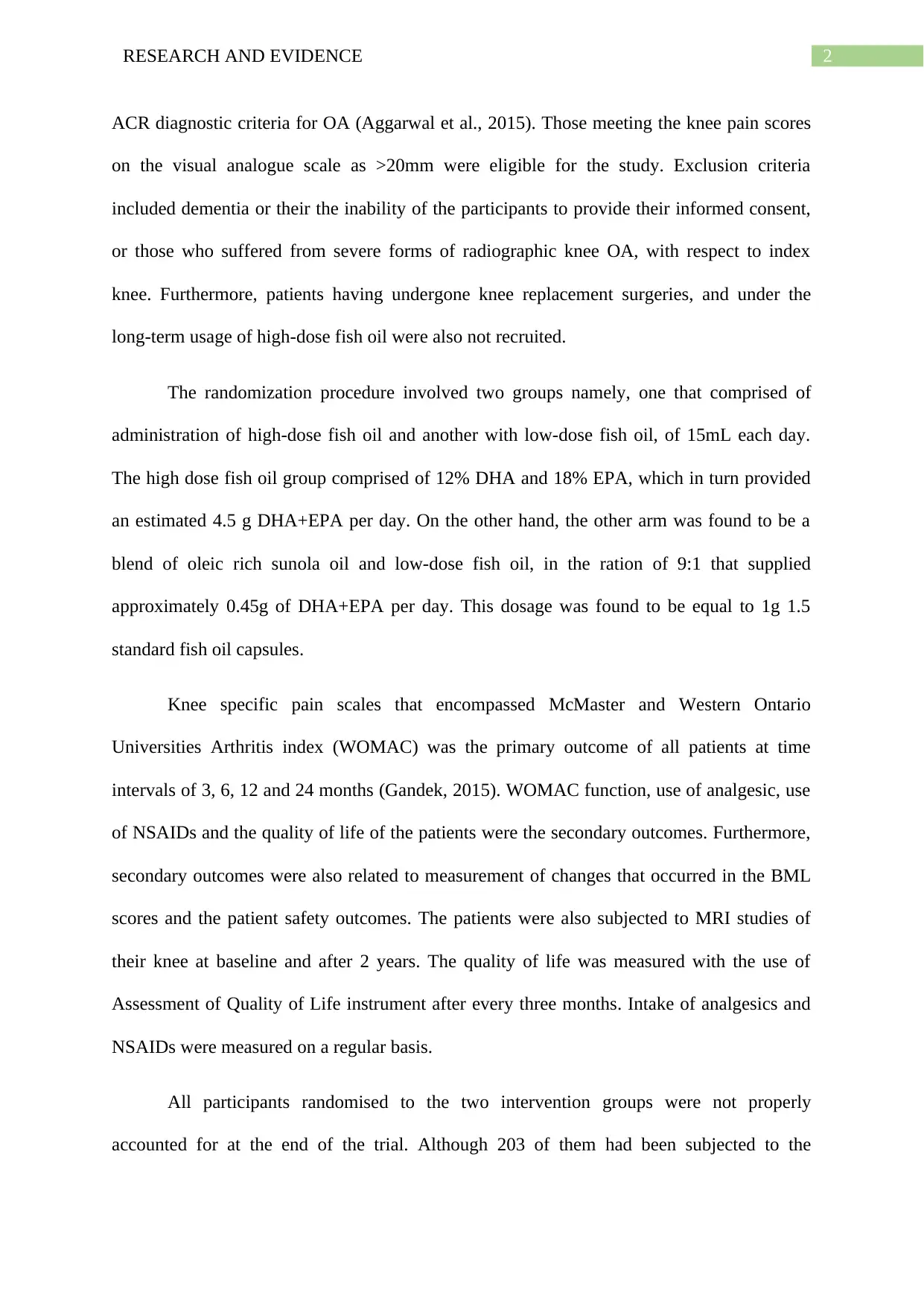
2RESEARCH AND EVIDENCE
ACR diagnostic criteria for OA (Aggarwal et al., 2015). Those meeting the knee pain scores
on the visual analogue scale as >20mm were eligible for the study. Exclusion criteria
included dementia or their the inability of the participants to provide their informed consent,
or those who suffered from severe forms of radiographic knee OA, with respect to index
knee. Furthermore, patients having undergone knee replacement surgeries, and under the
long-term usage of high-dose fish oil were also not recruited.
The randomization procedure involved two groups namely, one that comprised of
administration of high-dose fish oil and another with low-dose fish oil, of 15mL each day.
The high dose fish oil group comprised of 12% DHA and 18% EPA, which in turn provided
an estimated 4.5 g DHA+EPA per day. On the other hand, the other arm was found to be a
blend of oleic rich sunola oil and low-dose fish oil, in the ration of 9:1 that supplied
approximately 0.45g of DHA+EPA per day. This dosage was found to be equal to 1g 1.5
standard fish oil capsules.
Knee specific pain scales that encompassed McMaster and Western Ontario
Universities Arthritis index (WOMAC) was the primary outcome of all patients at time
intervals of 3, 6, 12 and 24 months (Gandek, 2015). WOMAC function, use of analgesic, use
of NSAIDs and the quality of life of the patients were the secondary outcomes. Furthermore,
secondary outcomes were also related to measurement of changes that occurred in the BML
scores and the patient safety outcomes. The patients were also subjected to MRI studies of
their knee at baseline and after 2 years. The quality of life was measured with the use of
Assessment of Quality of Life instrument after every three months. Intake of analgesics and
NSAIDs were measured on a regular basis.
All participants randomised to the two intervention groups were not properly
accounted for at the end of the trial. Although 203 of them had been subjected to the
ACR diagnostic criteria for OA (Aggarwal et al., 2015). Those meeting the knee pain scores
on the visual analogue scale as >20mm were eligible for the study. Exclusion criteria
included dementia or their the inability of the participants to provide their informed consent,
or those who suffered from severe forms of radiographic knee OA, with respect to index
knee. Furthermore, patients having undergone knee replacement surgeries, and under the
long-term usage of high-dose fish oil were also not recruited.
The randomization procedure involved two groups namely, one that comprised of
administration of high-dose fish oil and another with low-dose fish oil, of 15mL each day.
The high dose fish oil group comprised of 12% DHA and 18% EPA, which in turn provided
an estimated 4.5 g DHA+EPA per day. On the other hand, the other arm was found to be a
blend of oleic rich sunola oil and low-dose fish oil, in the ration of 9:1 that supplied
approximately 0.45g of DHA+EPA per day. This dosage was found to be equal to 1g 1.5
standard fish oil capsules.
Knee specific pain scales that encompassed McMaster and Western Ontario
Universities Arthritis index (WOMAC) was the primary outcome of all patients at time
intervals of 3, 6, 12 and 24 months (Gandek, 2015). WOMAC function, use of analgesic, use
of NSAIDs and the quality of life of the patients were the secondary outcomes. Furthermore,
secondary outcomes were also related to measurement of changes that occurred in the BML
scores and the patient safety outcomes. The patients were also subjected to MRI studies of
their knee at baseline and after 2 years. The quality of life was measured with the use of
Assessment of Quality of Life instrument after every three months. Intake of analgesics and
NSAIDs were measured on a regular basis.
All participants randomised to the two intervention groups were not properly
accounted for at the end of the trial. Although 203 of them had been subjected to the
⊘ This is a preview!⊘
Do you want full access?
Subscribe today to unlock all pages.

Trusted by 1+ million students worldwide
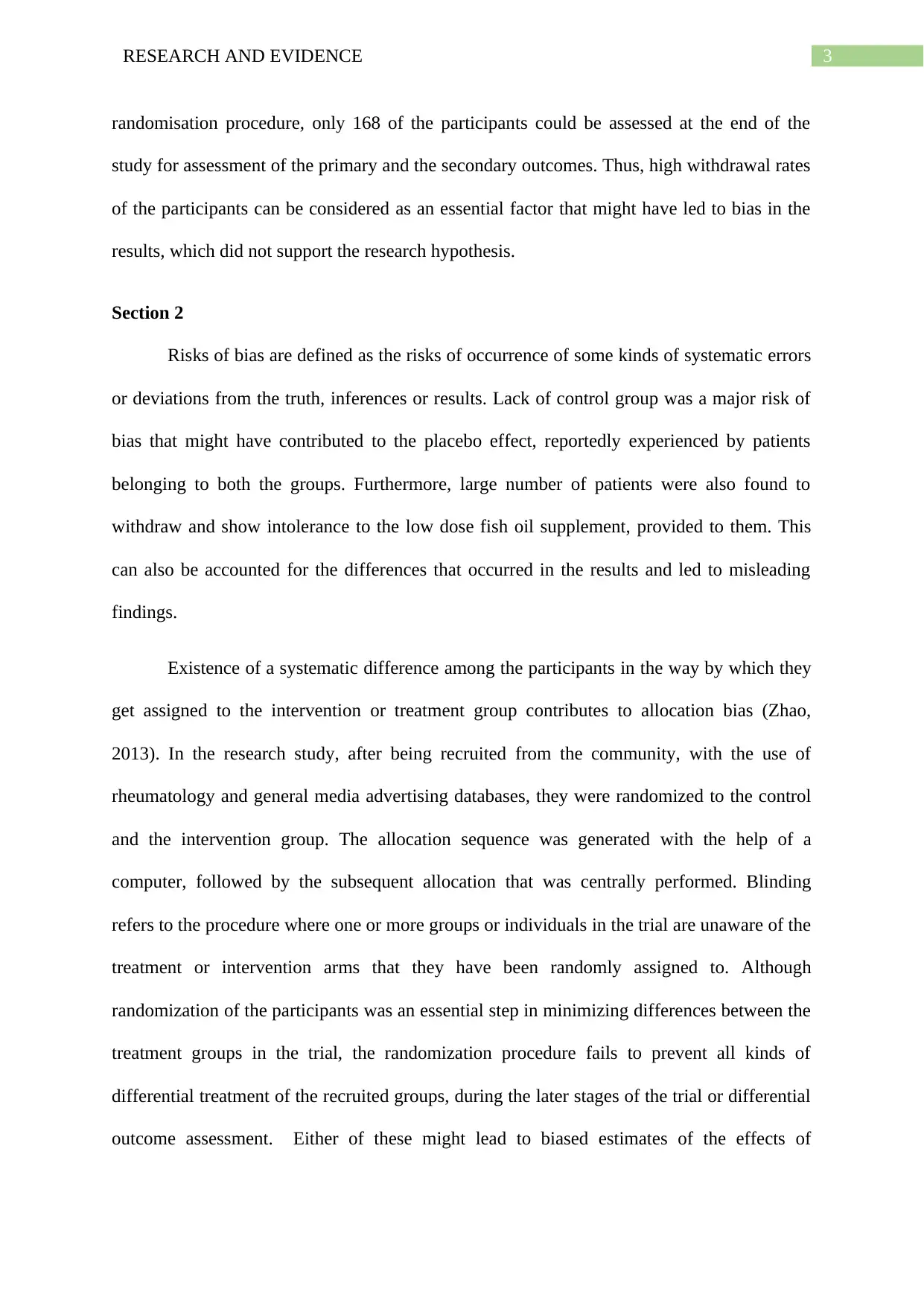
3RESEARCH AND EVIDENCE
randomisation procedure, only 168 of the participants could be assessed at the end of the
study for assessment of the primary and the secondary outcomes. Thus, high withdrawal rates
of the participants can be considered as an essential factor that might have led to bias in the
results, which did not support the research hypothesis.
Section 2
Risks of bias are defined as the risks of occurrence of some kinds of systematic errors
or deviations from the truth, inferences or results. Lack of control group was a major risk of
bias that might have contributed to the placebo effect, reportedly experienced by patients
belonging to both the groups. Furthermore, large number of patients were also found to
withdraw and show intolerance to the low dose fish oil supplement, provided to them. This
can also be accounted for the differences that occurred in the results and led to misleading
findings.
Existence of a systematic difference among the participants in the way by which they
get assigned to the intervention or treatment group contributes to allocation bias (Zhao,
2013). In the research study, after being recruited from the community, with the use of
rheumatology and general media advertising databases, they were randomized to the control
and the intervention group. The allocation sequence was generated with the help of a
computer, followed by the subsequent allocation that was centrally performed. Blinding
refers to the procedure where one or more groups or individuals in the trial are unaware of the
treatment or intervention arms that they have been randomly assigned to. Although
randomization of the participants was an essential step in minimizing differences between the
treatment groups in the trial, the randomization procedure fails to prevent all kinds of
differential treatment of the recruited groups, during the later stages of the trial or differential
outcome assessment. Either of these might lead to biased estimates of the effects of
randomisation procedure, only 168 of the participants could be assessed at the end of the
study for assessment of the primary and the secondary outcomes. Thus, high withdrawal rates
of the participants can be considered as an essential factor that might have led to bias in the
results, which did not support the research hypothesis.
Section 2
Risks of bias are defined as the risks of occurrence of some kinds of systematic errors
or deviations from the truth, inferences or results. Lack of control group was a major risk of
bias that might have contributed to the placebo effect, reportedly experienced by patients
belonging to both the groups. Furthermore, large number of patients were also found to
withdraw and show intolerance to the low dose fish oil supplement, provided to them. This
can also be accounted for the differences that occurred in the results and led to misleading
findings.
Existence of a systematic difference among the participants in the way by which they
get assigned to the intervention or treatment group contributes to allocation bias (Zhao,
2013). In the research study, after being recruited from the community, with the use of
rheumatology and general media advertising databases, they were randomized to the control
and the intervention group. The allocation sequence was generated with the help of a
computer, followed by the subsequent allocation that was centrally performed. Blinding
refers to the procedure where one or more groups or individuals in the trial are unaware of the
treatment or intervention arms that they have been randomly assigned to. Although
randomization of the participants was an essential step in minimizing differences between the
treatment groups in the trial, the randomization procedure fails to prevent all kinds of
differential treatment of the recruited groups, during the later stages of the trial or differential
outcome assessment. Either of these might lead to biased estimates of the effects of
Paraphrase This Document
Need a fresh take? Get an instant paraphrase of this document with our AI Paraphraser
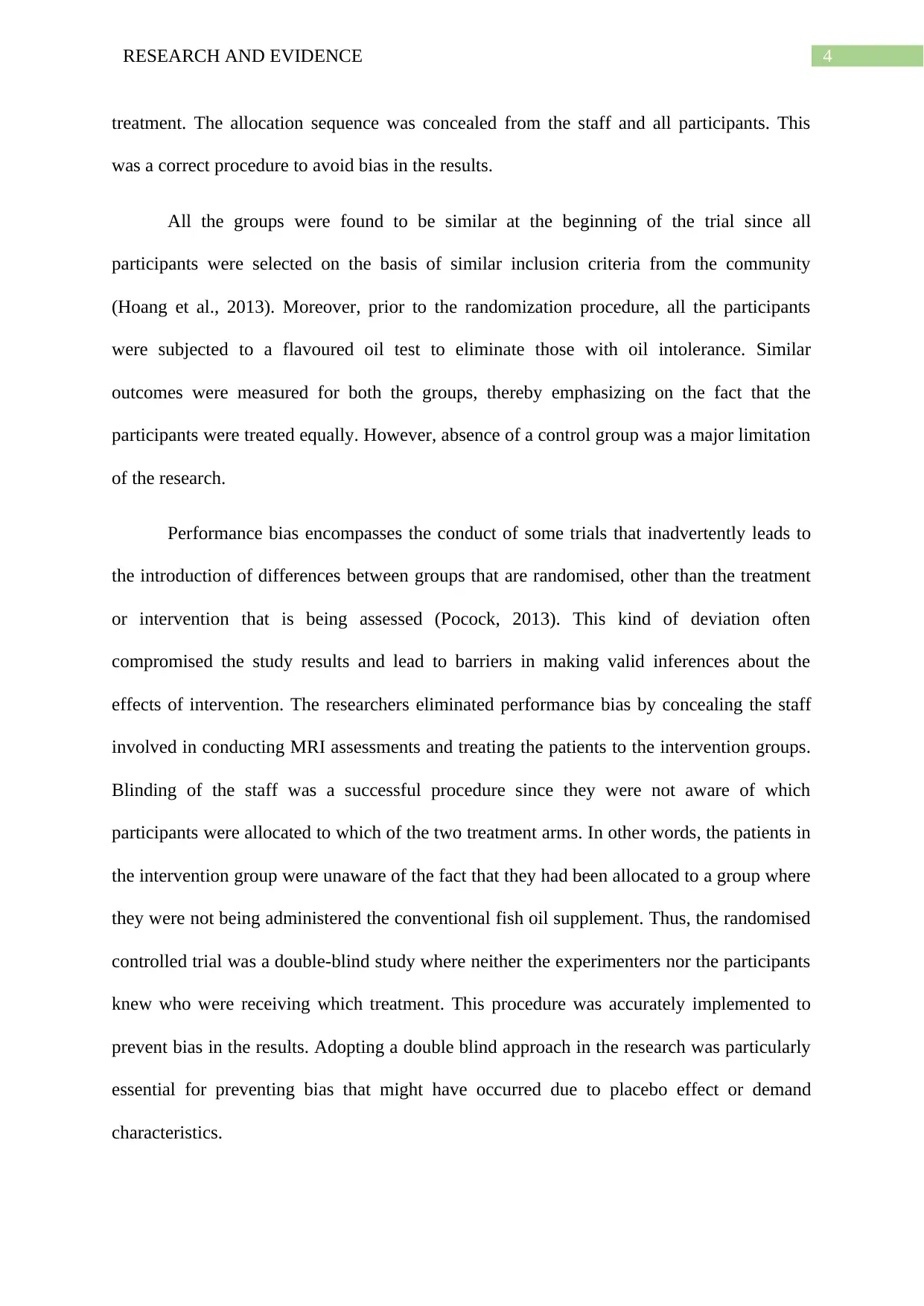
4RESEARCH AND EVIDENCE
treatment. The allocation sequence was concealed from the staff and all participants. This
was a correct procedure to avoid bias in the results.
All the groups were found to be similar at the beginning of the trial since all
participants were selected on the basis of similar inclusion criteria from the community
(Hoang et al., 2013). Moreover, prior to the randomization procedure, all the participants
were subjected to a flavoured oil test to eliminate those with oil intolerance. Similar
outcomes were measured for both the groups, thereby emphasizing on the fact that the
participants were treated equally. However, absence of a control group was a major limitation
of the research.
Performance bias encompasses the conduct of some trials that inadvertently leads to
the introduction of differences between groups that are randomised, other than the treatment
or intervention that is being assessed (Pocock, 2013). This kind of deviation often
compromised the study results and lead to barriers in making valid inferences about the
effects of intervention. The researchers eliminated performance bias by concealing the staff
involved in conducting MRI assessments and treating the patients to the intervention groups.
Blinding of the staff was a successful procedure since they were not aware of which
participants were allocated to which of the two treatment arms. In other words, the patients in
the intervention group were unaware of the fact that they had been allocated to a group where
they were not being administered the conventional fish oil supplement. Thus, the randomised
controlled trial was a double-blind study where neither the experimenters nor the participants
knew who were receiving which treatment. This procedure was accurately implemented to
prevent bias in the results. Adopting a double blind approach in the research was particularly
essential for preventing bias that might have occurred due to placebo effect or demand
characteristics.
treatment. The allocation sequence was concealed from the staff and all participants. This
was a correct procedure to avoid bias in the results.
All the groups were found to be similar at the beginning of the trial since all
participants were selected on the basis of similar inclusion criteria from the community
(Hoang et al., 2013). Moreover, prior to the randomization procedure, all the participants
were subjected to a flavoured oil test to eliminate those with oil intolerance. Similar
outcomes were measured for both the groups, thereby emphasizing on the fact that the
participants were treated equally. However, absence of a control group was a major limitation
of the research.
Performance bias encompasses the conduct of some trials that inadvertently leads to
the introduction of differences between groups that are randomised, other than the treatment
or intervention that is being assessed (Pocock, 2013). This kind of deviation often
compromised the study results and lead to barriers in making valid inferences about the
effects of intervention. The researchers eliminated performance bias by concealing the staff
involved in conducting MRI assessments and treating the patients to the intervention groups.
Blinding of the staff was a successful procedure since they were not aware of which
participants were allocated to which of the two treatment arms. In other words, the patients in
the intervention group were unaware of the fact that they had been allocated to a group where
they were not being administered the conventional fish oil supplement. Thus, the randomised
controlled trial was a double-blind study where neither the experimenters nor the participants
knew who were receiving which treatment. This procedure was accurately implemented to
prevent bias in the results. Adopting a double blind approach in the research was particularly
essential for preventing bias that might have occurred due to placebo effect or demand
characteristics.
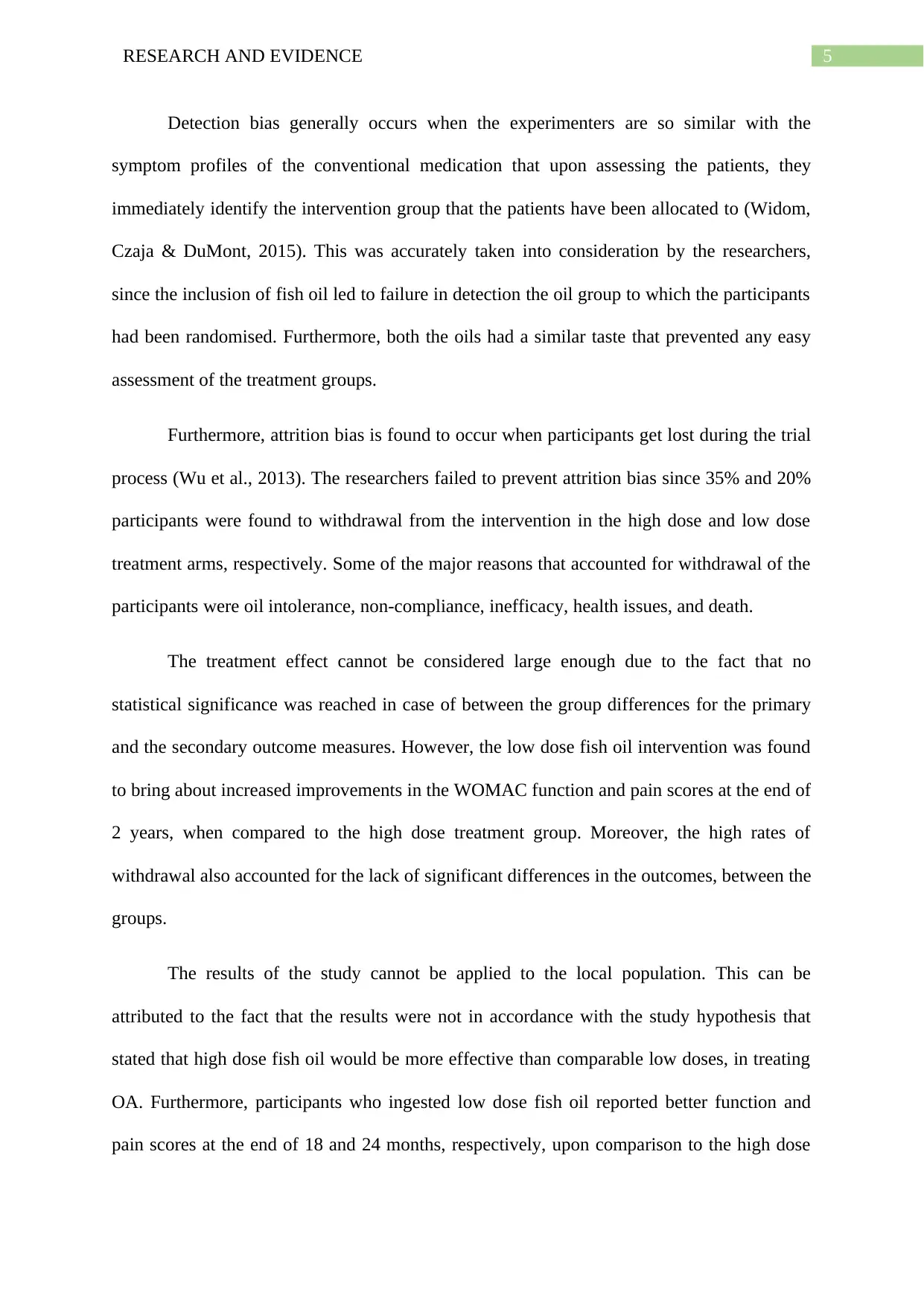
5RESEARCH AND EVIDENCE
Detection bias generally occurs when the experimenters are so similar with the
symptom profiles of the conventional medication that upon assessing the patients, they
immediately identify the intervention group that the patients have been allocated to (Widom,
Czaja & DuMont, 2015). This was accurately taken into consideration by the researchers,
since the inclusion of fish oil led to failure in detection the oil group to which the participants
had been randomised. Furthermore, both the oils had a similar taste that prevented any easy
assessment of the treatment groups.
Furthermore, attrition bias is found to occur when participants get lost during the trial
process (Wu et al., 2013). The researchers failed to prevent attrition bias since 35% and 20%
participants were found to withdrawal from the intervention in the high dose and low dose
treatment arms, respectively. Some of the major reasons that accounted for withdrawal of the
participants were oil intolerance, non-compliance, inefficacy, health issues, and death.
The treatment effect cannot be considered large enough due to the fact that no
statistical significance was reached in case of between the group differences for the primary
and the secondary outcome measures. However, the low dose fish oil intervention was found
to bring about increased improvements in the WOMAC function and pain scores at the end of
2 years, when compared to the high dose treatment group. Moreover, the high rates of
withdrawal also accounted for the lack of significant differences in the outcomes, between the
groups.
The results of the study cannot be applied to the local population. This can be
attributed to the fact that the results were not in accordance with the study hypothesis that
stated that high dose fish oil would be more effective than comparable low doses, in treating
OA. Furthermore, participants who ingested low dose fish oil reported better function and
pain scores at the end of 18 and 24 months, respectively, upon comparison to the high dose
Detection bias generally occurs when the experimenters are so similar with the
symptom profiles of the conventional medication that upon assessing the patients, they
immediately identify the intervention group that the patients have been allocated to (Widom,
Czaja & DuMont, 2015). This was accurately taken into consideration by the researchers,
since the inclusion of fish oil led to failure in detection the oil group to which the participants
had been randomised. Furthermore, both the oils had a similar taste that prevented any easy
assessment of the treatment groups.
Furthermore, attrition bias is found to occur when participants get lost during the trial
process (Wu et al., 2013). The researchers failed to prevent attrition bias since 35% and 20%
participants were found to withdrawal from the intervention in the high dose and low dose
treatment arms, respectively. Some of the major reasons that accounted for withdrawal of the
participants were oil intolerance, non-compliance, inefficacy, health issues, and death.
The treatment effect cannot be considered large enough due to the fact that no
statistical significance was reached in case of between the group differences for the primary
and the secondary outcome measures. However, the low dose fish oil intervention was found
to bring about increased improvements in the WOMAC function and pain scores at the end of
2 years, when compared to the high dose treatment group. Moreover, the high rates of
withdrawal also accounted for the lack of significant differences in the outcomes, between the
groups.
The results of the study cannot be applied to the local population. This can be
attributed to the fact that the results were not in accordance with the study hypothesis that
stated that high dose fish oil would be more effective than comparable low doses, in treating
OA. Furthermore, participants who ingested low dose fish oil reported better function and
pain scores at the end of 18 and 24 months, respectively, upon comparison to the high dose
⊘ This is a preview!⊘
Do you want full access?
Subscribe today to unlock all pages.

Trusted by 1+ million students worldwide

6RESEARCH AND EVIDENCE
group. Owing to the fact that the researchers failed to derive any significant benefits of high
dose supplementation of fish oil in knee OA patients, further investigation is required before
the findings can be applied in a local context.
group. Owing to the fact that the researchers failed to derive any significant benefits of high
dose supplementation of fish oil in knee OA patients, further investigation is required before
the findings can be applied in a local context.
Paraphrase This Document
Need a fresh take? Get an instant paraphrase of this document with our AI Paraphraser
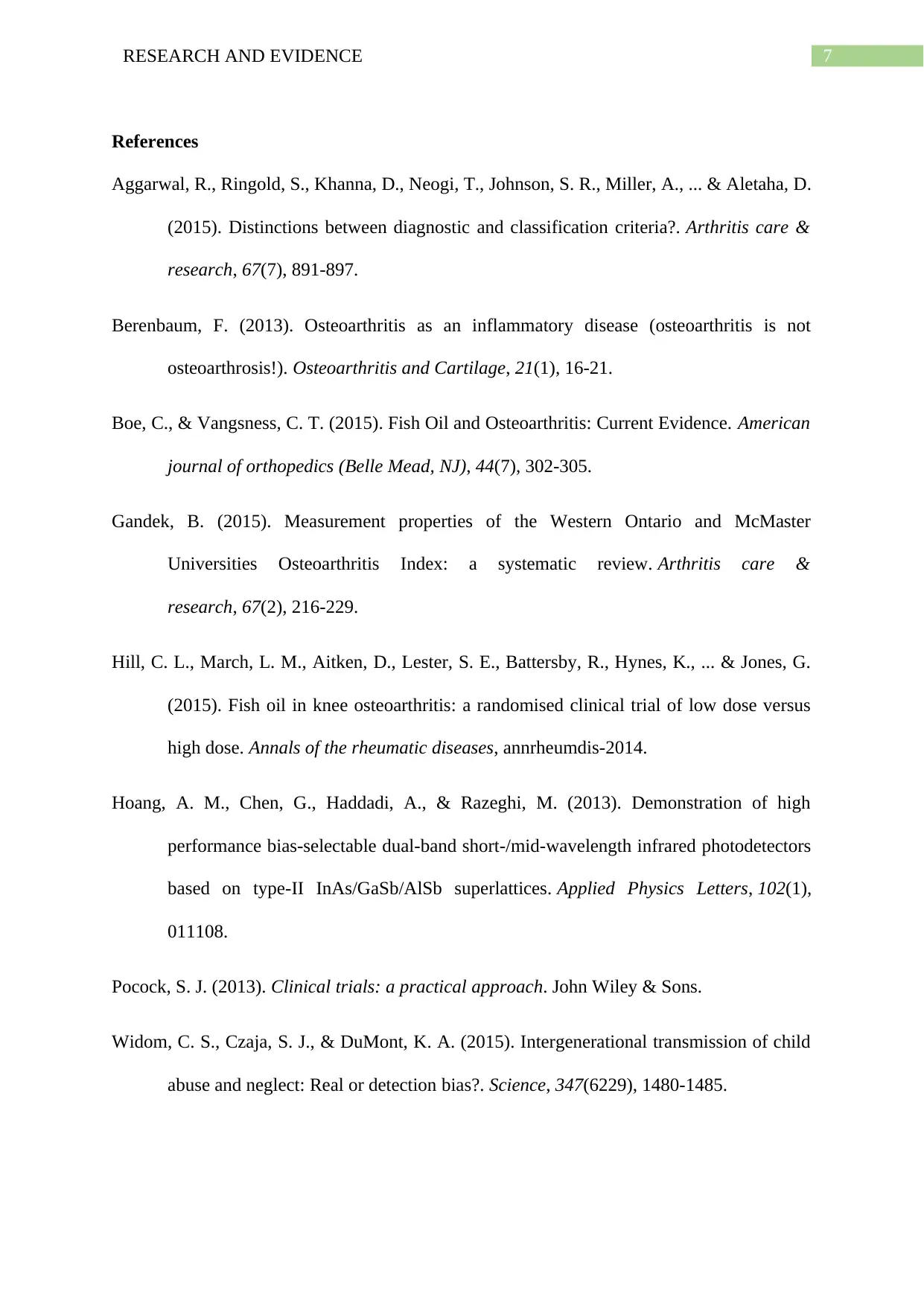
7RESEARCH AND EVIDENCE
References
Aggarwal, R., Ringold, S., Khanna, D., Neogi, T., Johnson, S. R., Miller, A., ... & Aletaha, D.
(2015). Distinctions between diagnostic and classification criteria?. Arthritis care &
research, 67(7), 891-897.
Berenbaum, F. (2013). Osteoarthritis as an inflammatory disease (osteoarthritis is not
osteoarthrosis!). Osteoarthritis and Cartilage, 21(1), 16-21.
Boe, C., & Vangsness, C. T. (2015). Fish Oil and Osteoarthritis: Current Evidence. American
journal of orthopedics (Belle Mead, NJ), 44(7), 302-305.
Gandek, B. (2015). Measurement properties of the Western Ontario and McMaster
Universities Osteoarthritis Index: a systematic review. Arthritis care &
research, 67(2), 216-229.
Hill, C. L., March, L. M., Aitken, D., Lester, S. E., Battersby, R., Hynes, K., ... & Jones, G.
(2015). Fish oil in knee osteoarthritis: a randomised clinical trial of low dose versus
high dose. Annals of the rheumatic diseases, annrheumdis-2014.
Hoang, A. M., Chen, G., Haddadi, A., & Razeghi, M. (2013). Demonstration of high
performance bias-selectable dual-band short-/mid-wavelength infrared photodetectors
based on type-II InAs/GaSb/AlSb superlattices. Applied Physics Letters, 102(1),
011108.
Pocock, S. J. (2013). Clinical trials: a practical approach. John Wiley & Sons.
Widom, C. S., Czaja, S. J., & DuMont, K. A. (2015). Intergenerational transmission of child
abuse and neglect: Real or detection bias?. Science, 347(6229), 1480-1485.
References
Aggarwal, R., Ringold, S., Khanna, D., Neogi, T., Johnson, S. R., Miller, A., ... & Aletaha, D.
(2015). Distinctions between diagnostic and classification criteria?. Arthritis care &
research, 67(7), 891-897.
Berenbaum, F. (2013). Osteoarthritis as an inflammatory disease (osteoarthritis is not
osteoarthrosis!). Osteoarthritis and Cartilage, 21(1), 16-21.
Boe, C., & Vangsness, C. T. (2015). Fish Oil and Osteoarthritis: Current Evidence. American
journal of orthopedics (Belle Mead, NJ), 44(7), 302-305.
Gandek, B. (2015). Measurement properties of the Western Ontario and McMaster
Universities Osteoarthritis Index: a systematic review. Arthritis care &
research, 67(2), 216-229.
Hill, C. L., March, L. M., Aitken, D., Lester, S. E., Battersby, R., Hynes, K., ... & Jones, G.
(2015). Fish oil in knee osteoarthritis: a randomised clinical trial of low dose versus
high dose. Annals of the rheumatic diseases, annrheumdis-2014.
Hoang, A. M., Chen, G., Haddadi, A., & Razeghi, M. (2013). Demonstration of high
performance bias-selectable dual-band short-/mid-wavelength infrared photodetectors
based on type-II InAs/GaSb/AlSb superlattices. Applied Physics Letters, 102(1),
011108.
Pocock, S. J. (2013). Clinical trials: a practical approach. John Wiley & Sons.
Widom, C. S., Czaja, S. J., & DuMont, K. A. (2015). Intergenerational transmission of child
abuse and neglect: Real or detection bias?. Science, 347(6229), 1480-1485.

8RESEARCH AND EVIDENCE
Wu, Q., Tchetgen, E. J. T., Osypuk, T. L., White, K., Mujahid, M., & Glymour, M. M.
(2013). Combining direct and proxy assessments to reduce attrition bias in a
longitudinal study. Alzheimer disease and associated disorders, 27(3), 207.
Zhao, W. (2013). Selection bias, allocation concealment and randomization design in clinical
trials. Contemporary clinical trials, 36(1), 263-265.
Wu, Q., Tchetgen, E. J. T., Osypuk, T. L., White, K., Mujahid, M., & Glymour, M. M.
(2013). Combining direct and proxy assessments to reduce attrition bias in a
longitudinal study. Alzheimer disease and associated disorders, 27(3), 207.
Zhao, W. (2013). Selection bias, allocation concealment and randomization design in clinical
trials. Contemporary clinical trials, 36(1), 263-265.
⊘ This is a preview!⊘
Do you want full access?
Subscribe today to unlock all pages.

Trusted by 1+ million students worldwide
1 out of 9
Related Documents
Your All-in-One AI-Powered Toolkit for Academic Success.
+13062052269
info@desklib.com
Available 24*7 on WhatsApp / Email
![[object Object]](/_next/static/media/star-bottom.7253800d.svg)
Unlock your academic potential
Copyright © 2020–2025 A2Z Services. All Rights Reserved. Developed and managed by ZUCOL.





